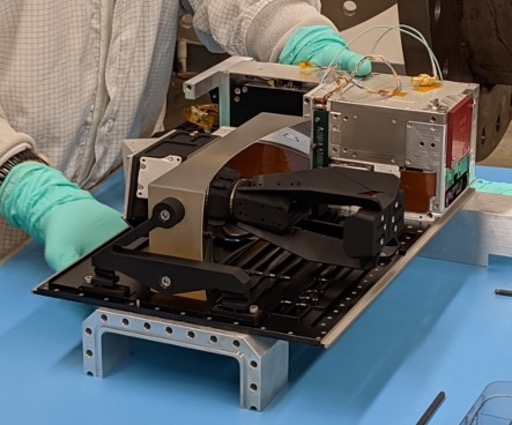The CUTE Mission: Innovative Design Enables Observations of Extreme Exoplanets from a Small Package
Of the approximately 5,500 exoplanets discovered to date, many have been found to orbit very close to their parent stars. These close-in planets provide a unique opportunity to observe in detail the phenomena critical to the development and evolution of our own solar system, including atmospheric mass loss and interactions with the host star. NASA’s […]

The CUTE Mission: Innovative Design Enables Observations of Extreme Exoplanets from a Small Package

NASA
Of the approximately 5,500 exoplanets discovered to date, many have been found to orbit very close to their parent stars. These close-in planets provide a unique opportunity to observe in detail the phenomena critical to the development and evolution of our own solar system, including atmospheric mass loss and interactions with the host star. NASA’s Colorado Ultraviolet Transit Experiment (CUTE) mission, launched in September 2021, employed a new design that enabled exploration of these processes using a small spacecraft for the first time. CUTE provides unique spectral diagnostics that trace the escaping atmospheres of close-in, ultra-hot, giant planets. In addition, CUTE’s dedicated mission architecture enables the survey duration required to characterize atmospheric structure and variability on these worlds.
Atmospheric escape is a fundamental process that affects the structure, composition, and evolution of many planets. It has operated on all of the terrestrial planets in our solar system and likely drives the demographics of the short-period planet population characterized by NASA’s Kepler mission. In fact, atmospheric escape ultimately may be the determining factor when predicting the habitability of temperate, terrestrial exoplanets. Escaping exoplanet atmospheres were first observed in the hydrogen Lyman-alpha line (121nm) in 2003. However, contamination by neutral hydrogen in both the intervening interstellar medium and Earth’s upper atmosphere makes obtaining high-quality Lyman-alpha transit measurements for most exoplanets very challenging. By contrast, a host star’s near-ultraviolet (NUV; 250 – 350 nm) flux is two to three orders of magnitude higher than Lyman-alpha, and transit light curves can be measured against a smoother stellar surface intensity distribution.
This knowledge motivated a team led by Dr. Kevin France at the University of Colorado Laboratory for Atmospheric and Space Physics to design the CUTE mission (Fig 2). The team proposed the CUTE concept to NASA through the ROSES/Astrophysics Research and Analysis (APRA) Program in February 2016 and NASA funded the project in July 2017. The CUTE instrument pioneered use of two technologies on a small space mission: a novel, rectangular Cassegrain telescope (20cm × 8cm primary mirror) and a miniature, low-resolution spectrograph operating from approximately 250 – 330 nm. The rectangular telescope was fabricated to accommodate the unique instrument volume of the 6U CubeSat form factor, an adaptation that delivers approximately three times the collecting area of a traditional, circular aperture telescope. The compact spectrograph meets the spectral resolution requirements of the mission while using scaled down component technology adapted from the Hubble Space Telescope.

This novel instrument design enables CUTE to measure NUV with similar precision as larger missions even in the more challenging thermal and pointing environment experienced by a CubeSat. In addition, the CUTE instrument’s NUV bandpass enables it to measure iron and magnesium ions from highly extended atmospheric layers that ground-based instruments cannot access. The CUTE science instrument is incorporated into a 6U Blue Canyon Technologies spacecraft bus that provides power, command and data handling, attitude control, and communications. This CubeSat platform enables CUTE to observe numerous transits of a given planet. The spectrogram from the CUTE instrument is recorded on a UV-optimized commercial off-the-shelf charge-coupled device (CCD), onboard data processing is performed, and data products are relayed to a ground station at the University of Colorado.

CUTE was launched as a secondary payload on NASA’s LANDSAT-9 mission on September 27, 2021 into a Sun-synchronous orbit with a 560 km apogee. CUTE deployed from the payload dispenser (Fig 3) approximately two hours after launch and then deployed its solar arrays. Spacecraft beacon signals were identified by the amateur radio community on the first orbit and communications were established with the ground station at the University of Colorado the following day. On-orbit commissioning of the spacecraft and instrument concluded in February 2022 and the mission has been conducting science operations since that time.
As of February 2024, CUTE is actively acquiring science and calibration data (Fig 4), and has observed between 6 and 11 transits of seven different exoplanetary systems. Data downlink efficiency is the primary factor limiting the number of targets observed over the course of the mission. CUTE light curves and transit spectroscopy are revealing extended NUV atmospheres on some planets (Fig 5) and potential time variability in the atmospheric transmission spectra of others. For example, observations of the ultra-hot exoplanet, Jupiter WASP-189b, indicate a highly extended atmosphere. Magnesium ions are observed to be gravitationally unbound from the planet, which is evidence for active escape of heavy elements in this system. CUTE data are being archived by the NASA Exoplanet Science Institute (NExScI).


CUTE successfully demonstrated the use of a non-circular telescope and miniature spectrograph design for small space missions, an approach that has been subsequently adopted by several NASA and international mission designs, including NASA’s new Monitoring Activity from Nearby sTars with uv Imaging and Spectroscopy (MANTIS) mission. CUTE’s demonstration of sub-1% NUV precision has shown that the precision achieved by large UV astronomy missions can also be achieved by a CubeSat. In addition, student training and early-career mentorship have been key ingredients to CUTE’s mission success. So far, over 20 early career students and professionals have trained and participated in CUTE activities—ranging from science to engineering to operations.
PROJECT LEAD
Professor Kevin France, Laboratory for Atmospheric and Space Physics/University of Colorado
SPONSORING ORGANIZATION
Astrophysics Division Astrophysics Research and Analysis Program
Share
Details
Related Terms
What's Your Reaction?



















.jpg?#)


































